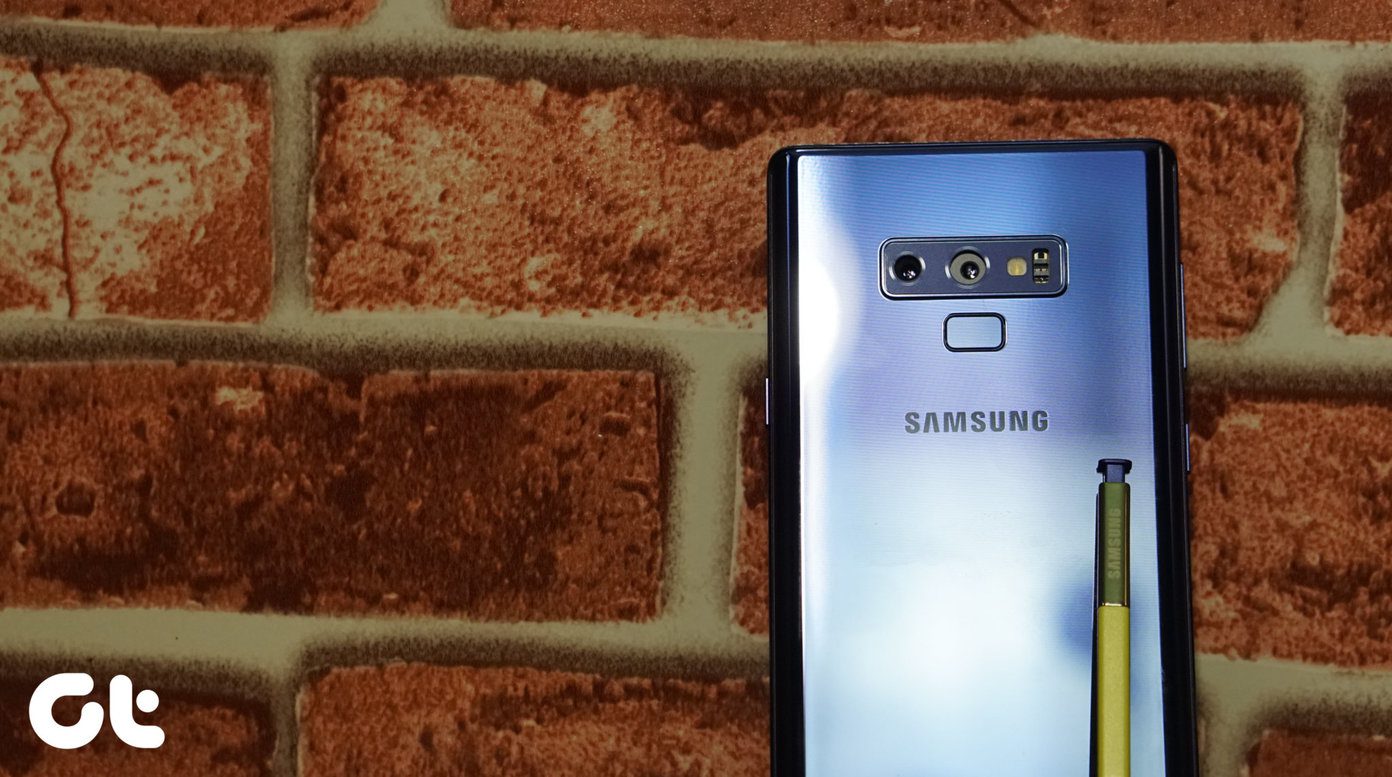The power users know that the first thing they must do after pulling the phone out — customize it. So, if you have recently bought the Samsung Galaxy S10 or the Galaxy S10 Plus, here are a bunch of tips and tricks to help you get the most out of it. Buy
Samsung Galaxy S10 Plus (128GB | 8GB)
As it is going to be a long post, let’s get started.
1. Change the Navigation Type
By default, the Samsung Galaxy S10 arrives with the conventional navigation bar at the bottom. But it’s 2019, and the solid navbar steals the dynamic look of the phone. The good news is that this phone provides navigational gestures which look cool and let you make the best of the screen space. To switch to this mode, go to Settings > Display > Navigation bar, and select Full screen display. From now on, swipe up from the left corner to pull up the Overview Selection and swipe up from the bottom-right corner to go back. To go Home, swipe up from the middle of the screen.
2. Hide That Punch Hole
Are those punch holes not up to your liking? If yes, don’t despair for these holes can be easily hidden. The only downside is that you must sacrifice some screen space. However, if you are still willing to go ahead with it, go to Display Settings > Full Screen Apps and toggle the switch for Hide front camera. I quite like those quirky punch hole cameras. The only downside is that I tend to pull down the notification window by swiping down from the top right corner. That leaves some smudges on the camera. Sadly, I can’t do much except change my habit. If only Samsung placed the Settings icon on the left. Sigh.
3. Explore Overview Selection Mode
Thanks to Android 9.0 Pie and One UI, accessing some controls like the Pop up View, App Info or Split Screen is pretty simple. Now, instead of diving into settings, these options are baked into the Overview Selection section aka Recents menu. To access them, open the Recents menu and tap on the app icon. So convenient!
4. Explore Edge Settings and Display
The Edge Panels are perhaps one of the best features of the Samsung flagships. All you need to do is swipe right from the edge of the screen, and the UI will present you with a bunch of screen panels. With these panels, you can quickly access your favorite apps and contacts. But the best thing about Edge Panels is that you can customize them fully. For example, if you want the Apps panel before the People panel or want to add/remove a few panels — all that is possible. Also, you can change the edge panel access side from right to left. All these settings are available under Display > Edge Screen > Edge panels. Select the respective panels by tapping on the empty circle at the top to enable the panels. To change the color or the side of the handle, tap on the three-dot menu and select Edge panel handle. While you’re at it, tweak the Edge lighting as well. The Galaxy S10 Plus provides plenty of lighting effects. From multicolored effects to throbbing edges, you get a lot of options after tapping on Edge lighting style.
5. Switch From the Screen Mode
The Dynamic AMOLED display of the Galaxy S10 Plus is one of the best displays right now. However, while I was setting it up, I felt that the screen was lacking a certain zing. It turns out that the S10 arrives with a screen mode set to Natural, which ends giving the screen a plain look. If you are someone who prefers their phone screen to have accentuated colors, the best bet would be to switch to the Vivid mode. To change the settings, head over to Display Settings > Screen mode and choose Vivid. Also, you can move the slider to the left if you love bluish hue.
6. Configure Always On Display
Allow me to repeat — the Dynamic AMOLED panel is gorgeous. Hence, it makes only sense to switch on the Always On Display (AOD). This neat feature not only displays weather info, notifications, time, and the battery percentage but also gives your phone a super chic look. To add to it, you can opt for stylish watch faces to display on top of it. To enable AOD, head over to Lock Screen settings and toggle the switch on. To customize it further, tap on the card and select Display mode. Now, choose Show always. Next, go back to the Lock Screen settings page and tap on Clock style. Select Always On Display to see the various options. Just pick one and hit the Done button. Lock your phone and witness the magic come alive.
7. Enable Fingerprint Icon
The in-display ultrasonic fingerprint scanner must be one of the coolest features in the Galaxy S10 Plus. It’s fast and accurate (well, most of the time). However, the problem with in-display fingerprint scanners is that it’s easy to miss it, especially when the display is off. In such cases, the best option is to enable the Fingerprint scanner icon. The S10 Plus makes the icon visible when you tap on the phone, even when the screen is off. To switch it on, head over to Biometrics and Security > Fingerprints, and toggle the switch for ‘Show icon when the screen is off’. Once you’ve memorized its location, you can toggle it off. To unlock your phone, tap once on the screen and press your thumb against the screen.
8. Switch to Night Mode to Save Battery
Samsung phones are not known to deliver a long battery life. The display and stark white interface of the default apps made it difficult to save juice. Fortunately, this year Samsung finally introduced the Night mode aka Dark mode. With AMOLED screens, the interface instructs the screen to turn off the sub-pixels to show black. That ends up saving some battery juice. To enable it, go to Display settings and toggle the switch for Night mode. Now, all the native apps along with the Settings pages will be painted black. Hello, darkness.
9. Configure Adaptive Power Saving
Another battery saving feature is the Adaptive Power Saving mode. This Android 9.0 Pie-centric feature uses machine learning to monitor and learn about your app usage patterns and in the process, pushes the least used apps to a low power state. To switch it on, head over to Device Care in settings, tap on Power mode and enable the last option. Quite naturally, this is an ongoing process, and you won’t see the results overnight.
10. Set Notification Reminders
Speaking of notifications, did you know your new phone can send you a reminder for missed notifications, and that too for specific apps? No kidding. You can find the settings by searching for Notification Reminder in Settings app. All you have to do is select the Remind every option to choose the time interval. Next, tap on Selected apps and enable the switch for the apps that you want.
11. Activate Video Enhancer
Another cool feature is the Video Enhancer mode. As suggestive of its name, it gives a rich and vivid look to the videos that you watch on your phone. The good news is that you don’t have to switch it on every time you open Netflix or YouTube. It kicks in automatically once it detects a video playing. The settings for it are available under the Advanced Settings. Once you locate it, simply enable the switch. Video enhancer is not entirely a new feature. It made its debut with the Samsung Galaxy S7.
12. Make Use of Bixby Routines
Bixby Routines is a new feature in the Galaxy S10 Plus wherein the digital assistant learns from your behavior and suggests ways to save more time. That can be anything like tweaking the system settings or launching apps when it meets certain requirements. Plus, you can add a few routines. Using routines, you can program your phone to behave in a specific manner. These are a set of IFTTT-like instructions. So, if you want your phone to default to the silent mode and switch to the reading mode when the clock strikes 10 PM, it is doable through this setting. To explore this nifty feature, head to Advanced settings and tap on Bixby Routines.
13. Enable Digital Wellbeing
Lastly, the Galaxy S10 Plus bundles a Digital Wellbeing module. Though cellphones these days are more important than ever, it’s easy to get hooked to them. The Digital Wellbeing module attempts to solve that issue. It monitors and tracks your cellphone usage and gives you a visual representation of your phone habits such as screen time, number of times you’ve unlocked your phone and notifications. Moreover, you can also set timers for specific apps through the Dashboard option. Choose the app, and tap on the No timer option and select one as per your convenience. The first app that I put under monitoring was Instagram. What about you?
Be a Power User
Phew, that was quite a long list. Which one of these features did you set up first? Also, watch this video for a comprehensive list of tips and tricks for the Galaxy S10 Plus. Next up: The Galaxy Note 9 and the Galaxy S10 share similar audio features. Explore the following post to discover tips and enhance the audio experience on your Galaxy S10/S10 Plus. Buy
Samsung Galaxy S10 Plus (128GB | 8GB)
The above article may contain affiliate links which help support Guiding Tech. However, it does not affect our editorial integrity. The content remains unbiased and authentic.













































